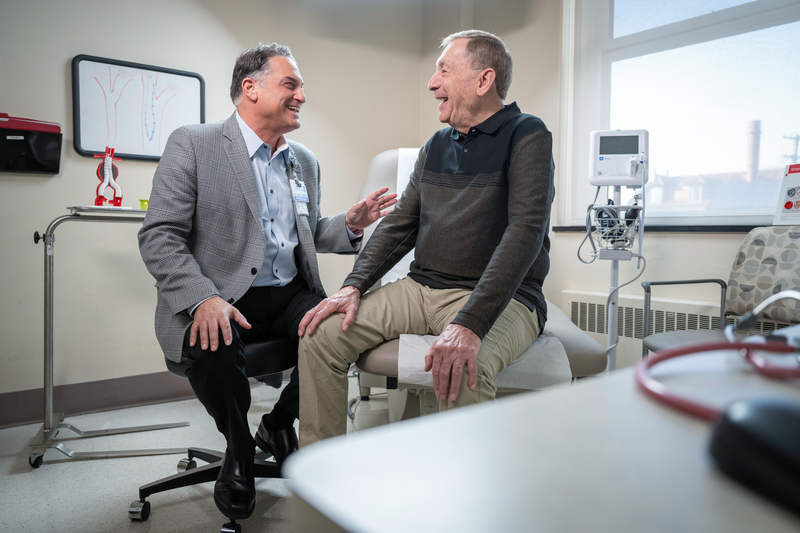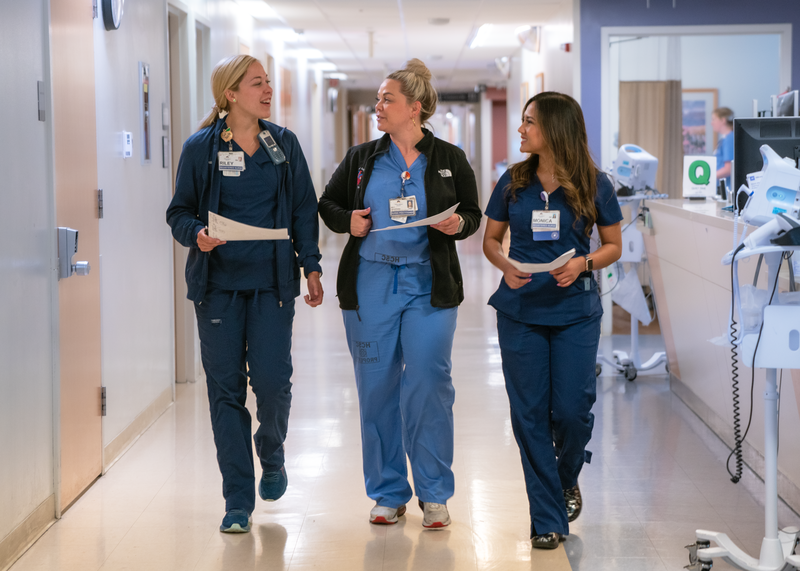Expertise is the name of our game. Our highly experienced vascular surgeons are closely involved in all the care our team provides.
Along with our dedicated staff with specialized training in vascular care, we'll work closely with you to create a personalized treatment plan that addresses your unique needs and concerns.
From the routine to the cutting-edge, we have what it takes to treat blood vessel disorders with high-quality care and compassion.
Carotid artery disease treatments
The carotid artery carries blood from the heart through the neck to the brain. If plaque builds up in the artery — a condition known as carotid artery disease — it can reduce or block the flow, raising the risk of stroke. Carotid artery disease is a common cause of strokes and mini-strokes.
In addition to medical treatment, WellSpan vascular specialists treat carotid disease surgically, using either endarterectomy or minimally invasive stenting when necessary. Endarterectomy is a surgical procedure that removes plaque in the carotid artery. A stent pushes plaque to the artery walls, widening the artery to help restore blood flow.
Minimally invasive aortic aneurysm repair
Minimally invasive endovascular aneurysm repair (EVAR and TEVAR) is an alternative to open aneurysm surgery, which is required in some cases.
In the EVAR and TEVAR procedures, your WellSpan vascular surgeon will insert catheters (long, narrow tubes) through a small incision in the groin. Our vascular surgeons can also access veins percutaneously (pTEVAR and pEVAR), which is with needle sticks rather than incisions. We then pass a covered stent through the artery and position it across the aneurysm to prevent it from enlarging or rupturing.
Your WellSpan vascular surgeon will help you choose between open and minimally invasive repair for your aortic aneurysm.
Varicose and spider vein treatments
Your veins contain valves designed to keep the blood flowing toward the heart. When these valves weaken or fail, you may experience varicose veins, especially in the legs.
One treatment option is endovenous ablation therapy. Your WellSpan doctor will insert a catheter into the vein and use heat to seal off the varicose vein, allowing healthy veins to restore blood flow.
WellSpan offers a range of treatment options to remove or diminish unsightly varicose and spider veins. Your WellSpan vascular surgeon will discuss which options are right for you, based on your age, health condition and personal goals. With these treatments, many people can go home the same day as their procedure.
Dialysis access fistulas, grafts and catheter placement
People who receive hemodialysis need a reliable point of access to their bloodstream — called vascular access — so that blood can be cleaned and returned to the body at a high volume and speed.
Our vascular surgeons can create dialysis access through either an arteriovenous fistula, a surgically created direct connection between the artery and superficial veins in your arms, or an arteriovenous graft, which places a plastic tube under the skin to connect the artery to the veins. Your WellSpan vascular surgeon can explain which one best supports your medical condition.
Endovascular interventions
Endovascular interventions allow doctors to treat vascular conditions throughout the body by means of the major blood vessels. For example, our vascular specialists can insert a balloon, stent or coil with a catheter to widen an artery blocked by atherosclerosis and restore blood flow.
Because these procedures are minimally invasive, there’s less scarring and recovery times can be faster.
Open bypass surgery and endovascular interventions for PAD and diabetic foot ulcers
Treatment of PAD, claudication and diabetic foot ulcers includes medical and exercise therapy and proper wound care for ulcers. When the circulation to your legs is severely reduced or blocked, your WellSpan vascular specialist can treat the blockage with either open bypass surgery, endovascular interventions or a combination of both.
Open bypass surgery involves using your own veins or a plastic tube to bypass blocked areas in leg arteries.
Endovascular interventions allow doctors to treat vascular conditions by means of a balloon, a stent or an atherectomy device. This treatment involves inserting a catheter and using one of these devices to widen an artery blocked by atherosclerosis and restore blood flow.
How we can help
Vascular conditions — conditions related to the veins and arteries — run the gamut from small spider veins to life-threatening aneurysms and arterial disease.
Whatever vascular challenge you’re facing, WellSpan’s vascular and endovascular surgery team is dedicated to returning you to good health as soon as possible.
Our highly qualified, board-certified doctors are at the top of their field, ensuring you get outstanding care that’s backed by the latest research. Coupled with our providers’ expertise, the advanced medical technologies we use give you the broadest range of treatment options, from minimally invasive, catheter-based techniques to open surgery when indicated.
As a vascular patient at WellSpan, your goals are our goals. Once we know what you want to accomplish, we’ll create a treatment plan designed to put those outcomes within reach.
It won’t just be your doctor working for you. Instead, we support your recovery by leveraging our vast network, including other vascular specialists within WellSpan and beyond, providers in related fields, community organizations and even your family, friends and coworkers.


